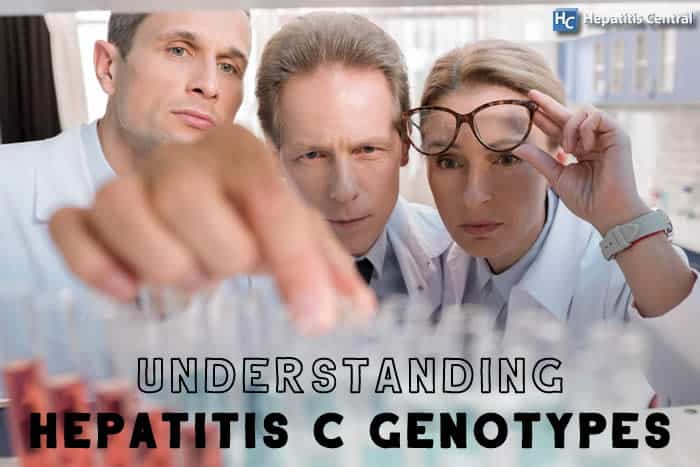Understanding Hepatitis C Genotypes


Hepatitis is inflammation of the liver, potentially stemming from a variety of different causes. A virus, alcohol, medications, toxins or an autoimmune disease can cause hepatitis.
One of the viruses that cause inflammation of the liver is hepatitis C, a viral infection that frequently becomes a chronic liver disease. The Hepatitis C virus can have several variations, representing slight differences in the virus’s genetic code.
According to the Centers for Disease Control and Prevention (CDC), at least six distinct hepatitis C genotypes have been identified.
Determining which hepatitis C genotype is causing the viral infection of the liver is crucial for treatment – as different medicines are more effective for different genotypes.
Hepatitis C Genotypes and Subtypes
The hepatitis C genotypes are labeled one through six. In addition to six genotypes, there are more than 67 hepatitis C subtypes, labeled with letters (such as genotype 1a and 1b).
While most hepatitis C infections are attributed to a single, dominant genotype, it is possible to be infected with more than one at the same time. This is known as a mixed infection.
Anyone infected with the hepatitis C virus is vulnerable to liver damage; however, some of the genotype and subtype genetic variations are more susceptible to a particular type of liver damage:
- Hepatitis C genotype 1b infections are more likely to develop cirrhosis (severe liver scarring).
- Hepatitis C genotypes 1b and 3 infections have a greater risk of developing into liver cancer.
General Genotype Grouping
In general, some genotypes or subtypes are more common in specific locations, racial or ethnic groups.
For example:
- Over 90 percent of African Americans in the U.S. with hepatitis C have genotype 1.
- About 67 percent of Caucasians in the U.S. with hepatitis C have genotype 1.
- Genotypes 1, 2 and 3 are found worldwide.
- Genotype 4 occurs predominantly in the Middle East, Egypt and Central Africa.
- Genotype 5 is present almost exclusively in South Africa.
- Genotype 6 is predominantly seen in Southeast Asia.
- Genotype 1 is the most common genotype in the United States.
- Genotype 1 is found in nearly 75 percent of all hepatitis C infections in the U.S. Most of the remaining people in the United States with hepatitis C infection carry genotypes 2 or 3.
Despite these types of trends, someone from any location, racial or ethnic group can have any hepatitis C genotype or subtype.
More on Genotype 3
Hepatitis C genotype 3 seems to be emerging as one of the harder variants to treat. Genotype 3 has been associated with unique characteristics that impair treatment with direct-acting antiviral medications.
Two of hepatitis C genotype 3’s characteristics are:
- its influence on creating resistance to insulin
- its influence on causing the liver to break down fats
Infection with hepatitis C genotype 3 presents the biggest treatment challenges if the patient:
- has previously tried treatment and failed
- has cirrhosis
- has decompensated liver disease (a precarious condition that can lead to liver failure)
Hepatitis C genotype 3 often requires longer treatment and tends to be associated with lower cure rates*. These rates are even lower in patients with cirrhosis.
Hepatitis C Genotypes and Treatment
There are new medications continually in development for hepatitis C – and recommendations typically depend on the person’s genotype and other factors (such as co-existing medical conditions, previous treatment attempts, anddegree of liver damage).
The drugs listed below may or may not contain the most up-to-date information – they are just intended to demonstrate how treatments differ based on Hepatitis C genotype:
- Genotype 1 – The direct-acting antiviral drugs boceprevir and telaprevir are very effective for hepatitis C genotype 1. These medications can also be somewhat effective for people with genotype 2. With sofosbuvir, hepatitis C genotype 1 has a cure rate* of more than 90 percent in as few as three months.
The Viekira Pak (ombitasvir, paritaprevir, and ritonavir, with dasabuvir) is used for genotype 1, 1a and 1b. For those who have never been treated before, the cure rate* with Viekira Pak is about 95 percent. For those with cirrhosis or who have been treated before with other drugs, Viekira Pak is used with ribavirin and has a cure rate* of 80 to 90 percent.
- Genotype 2 – Daclatasvir plus sofosbuvir has greater than a 90 percent cure rate* for people with hepatitis C genotype 2.
- Genotype 3 – Although peg-interferon plus and ribavirin has a cure rate* of 65-80 percent for hepatitis C genotype 3, newer pangenotypic drugs may be even more successful.
- Genotype 4 – The drug Technivie (a combination of ombitasvir, paritaprevir and ritonavir) together with ribavirin has an estimated 91 percent cure rate* for hepatitis C genotype 4.
- Genotypes 1 and 4 – The drug Zepatier (a combination of elbasvir and grazoprevir) has a cure rate* between 94 and 100 percent for genotypes 1 and 4 in three months.
- Genotypes 1, 4, 5 and 6 – The drug Harvoni (a combination of ledipasvir and sofosbuvir) has an estimated cure rate* of 94 percent after three to six months of use for hepatitis C genotypes 1, 4, 5 and 6.
Some of the latest direct-acting antiviral treatments for Hepatitis C are pangenotypic, which means they can cure all genotypes at nearly the same rates.
These 3 pangenotypic medications are now available:
- Vosevi – A medication that combines sofosbuvir and velpatasvir, Vosevi boasts a 96-97 percent cure rate* in people with hepatitis C genotypes 1, 2, 3, 4, 5 and 6 without cirrhosis or with mild cirrhosis in just three months.
- Mavyret – A medication that combines glecaprevir and pibrentasvir, Mavyret claims a 92 to 100 percent cure rate* for people with hepatitis C genotypes 1, 2, 3, 4, 5 and 6 who do not have cirrhosis and have never been treated for hepatitis C before. Mavyret can be effective in as little as two months.
- Epclusa – A medication that combines sofosbuvir + velpatasvir, Epclusa treats hepatitis C genotypes 1, 2, 3, 4, 5 and 6. The cure rate* for Epclusa ranges between 80 and 100 percent, depending on the genotype, previous treatment, co-infection with HIV, and the stage of liver disease present.
*The term ‘cure rate’ is controversial. ‘Cure rate’ actually refers to the patient having achieved a sustained virologic response (SVR). SVR is zero detection of viral particles twelve months following the conclusion of treatment.
https://hepatitisc.net/living/recommended-treatments-for-genotypes-1-6/, Recommended Treatments for Chronic Hepatitis C Genotypes 1-6, Jenelle Marie Pierce, Retrieved December 31, 2018, Health Union LLC, 2018.
https://www.centerwatch.com/drug-information/fda-approved-drugs/drug/100130/zepatier-elbasvir-and-grazoprevir, Zepatier (elbasvir and grazoprevir), Retrieved December 31, 2018, CenterWatch, 2018.
https://www.empr.com/news/glecaprevir-pibrentasvir-hepatitis-c-virus-infection-pan-genotypic/article/679792/, FDA Approves Mavyret, a Pan-Genotypic Treatment for HCV, Retrieved December 31, 2018, Haymarket Media, Inc., 2018.
https://www.healthline.com/health/hepatitis-c/ddg-new-treatment-options#1, Doctor Discussion Guide: New Treatment Options for Hep C, Retrieved December 31, 2018, Healthline Media, 2018.
https://www.healthline.com/health/hepatitis-c-genotype-expert#7, Hepatitis C Genotype: Your Questions Answered, Kenneth R. Hirsch, MD, Retrieved December 14, 2018, Healthline Media, 2018.
https://www.healthline.com/health/hepatitis-c/harvoni-viekira-pak#2, Harvoni and Viekira Pak: What’s the Difference?, Retrieved December 31, 2018, Healthline Media, 2018.
https://www.medscape.com/viewarticle/883095, FDA Clears Pan-Genotypic Vosevi for Chronic Hepatitis C, Megan Brooks, Retrieved December 31, 2018, WebMD, LLC, 2018.
http://www.treatmentactiongroup.org/hcv/factsheets/hcv-genotypes, HCV Genotypes, Retrieved December 14, 2018, Treatment Action Group, 2018.







